Best Lead Enrichment APIs for Developers 2025
Practical API choices and integration patterns for building scalable lead enrichment pipelines
Blogby JanAugust 13, 2025

Developer-focused teams are building the future of sales automation, and lead enrichment APIs sit at the heart of these innovations. With 70% of organizations planning to integrate AI and machine learning into their sales processes by 2025, the demand for flexible, powerful APIs that can turn raw contact data into actionable intelligence has never been higher.
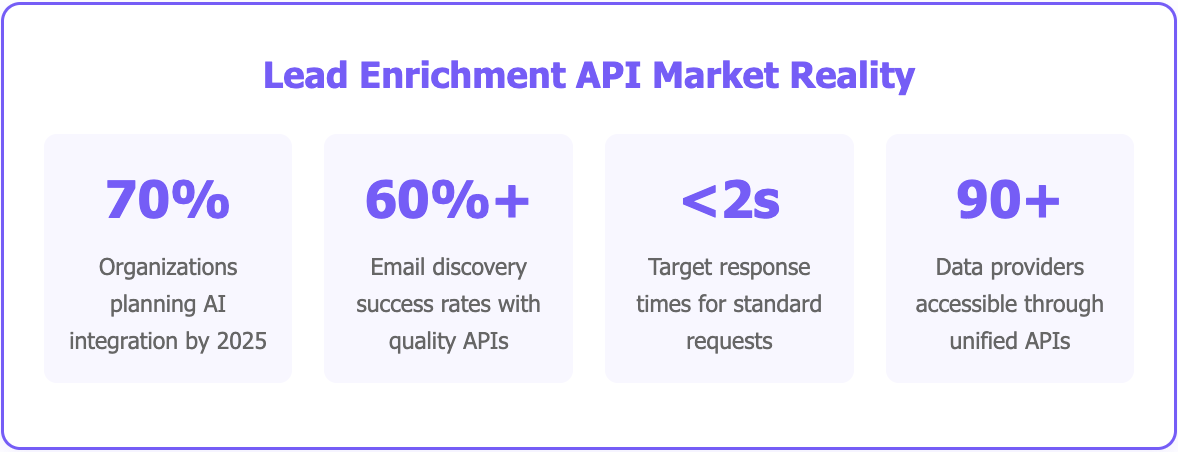
GTM teams and cold email agencies increasingly rely on custom-built solutions that leverage multiple data sources through programmatic interfaces. But with dozens of lead enrichment APIs available, each with different capabilities, pricing models, and integration requirements, choosing the right foundation for your development projects requires careful analysis.
We've analyzed documentation quality, and evaluated real-world implementation scenarios across the leading platforms. This guide provides the technical insights developers need to build robust lead enrichment systems that scale.
When APIs Are The Better Choice
Traditional lead enrichment platforms offer user-friendly interfaces but often lack the flexibility developers need for custom implementations. APIs provide direct access to data sources, enabling precise control over enrichment workflows, cost optimization, and integration with existing systems.
Real-time integration capabilities make all the difference. When a prospect fills out a form, visits your pricing page, or engages with your content, APIs can instantly append comprehensive data before routing leads to sales teams. This immediate enrichment significantly improves conversion rates by ensuring sales teams have complete context for every interaction.
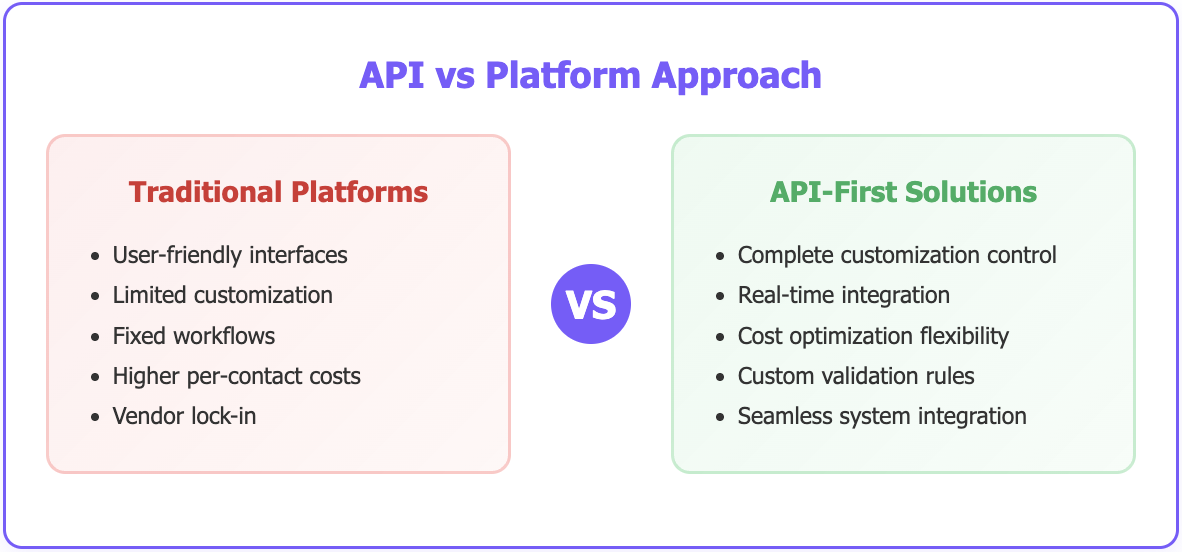
Unlike platform-based solutions, APIs allow developers to build enrichment workflows that match exact business requirements. You can implement conditional logic, create custom data validation rules, and design failover mechanisms that aren't possible with pre-built platforms. Cost optimization through selective enrichment becomes possible when you have granular control over when and how enrichment occurs.
What Matters in API Selection
Building effective lead enrichment systems requires understanding how different APIs handle data flow, error management, and rate limiting. Most developers focus on features, but operational characteristics often determine long-term success.
Data Flow Patterns
Synchronous enrichment processes data immediately and returns results within the API call. This approach works well for real-time applications but requires careful timeout handling and error management. Asynchronous processing accepts enrichment requests and returns results through webhooks or polling mechanisms. This pattern handles large batch processing more effectively and provides better resilience against temporary service issues.
Hybrid approaches combine both patterns, using synchronous calls for critical data points and asynchronous processing for comprehensive enrichment. This flexibility becomes crucial when building applications that serve different use cases.
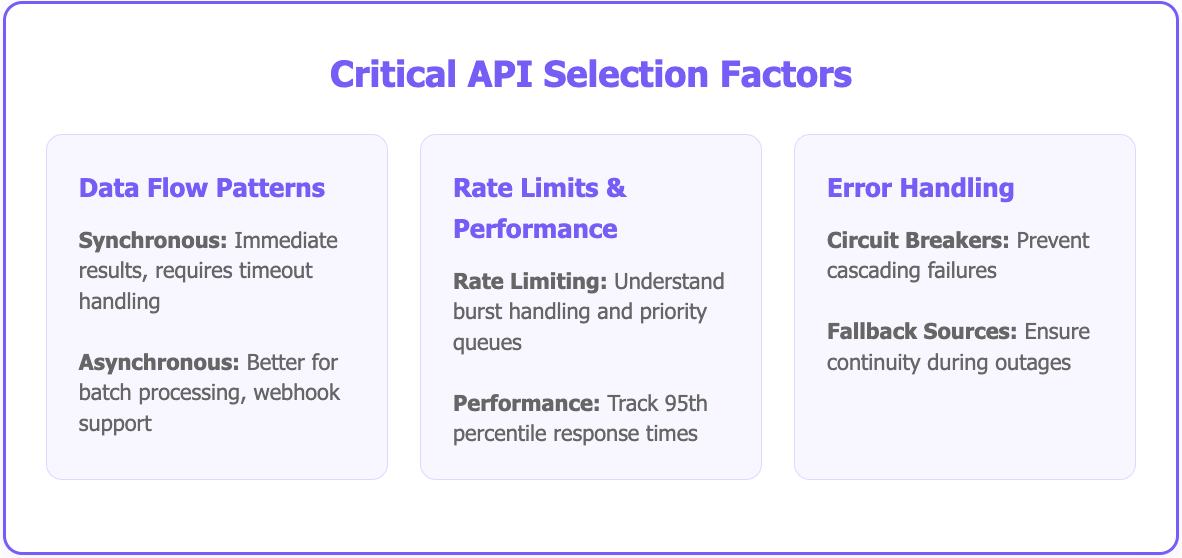
Rate Limits
Production lead enrichment APIs implement rate limiting to ensure service stability. Understanding these limits is crucial for application design. Most APIs provide rate limit information in response headers, allowing applications to adjust request timing dynamically.
Burst handling strategies help manage periodic high-volume requirements. Some APIs allow rate limit borrowing against future quotas, while others provide priority queues for premium customers. Caching strategies significantly improve performance and reduce API costs. Implementing intelligent caching that respects data freshness requirements while minimizing redundant calls requires careful design but delivers substantial operational benefits.
Error Handling
Robust lead enrichment systems implement comprehensive error handling for various failure scenarios. Network timeouts, API service interruptions, and data quality issues all require different response strategies. Circuit breaker patterns prevent cascading failures when APIs experience issues. Retry logic with exponential backoff handles temporary failures gracefully without overwhelming recovering services.
Fallback data sources ensure continuity when primary APIs are unavailable. This requires designing systems that can seamlessly switch between different enrichment providers based on availability and data quality.
Performance Deep Dive
When building production systems, API performance characteristics often matter more than feature lists.
Most lead enrichment APIs target response times under 2 seconds for standard enrichment requests. However, actual performance varies based on request complexity, data source availability, and geographic distribution. Latency monitoring should track not just average response times but also 95th and 99th percentile performance. Occasional slow responses can significantly impact user experience in real-time applications.
Data accuracy varies significantly between providers and data types. Email discovery typically achieves 60%+ success rates with quality APIs, while phone number enrichment often performs closer to 50-60%. Verification mechanisms help ensure data quality. Some APIs provide confidence scores with enrichment results, while others offer separate verification endpoints for critical data points.
Documentation quality directly impacts development velocity and long-term maintenance costs. The best lead enrichment APIs provide detailed examples, clear error codes, and interactive testing environments. SDK availability for popular programming languages reduces integration complexity. Official SDKs typically handle authentication, rate limiting, and error handling more elegantly than custom implementations.
The Top APIs That Deliver
The lead enrichment API environment offers several strong options, each with distinct technical characteristics and use case strengths.
Databar.ai: Built for Developers
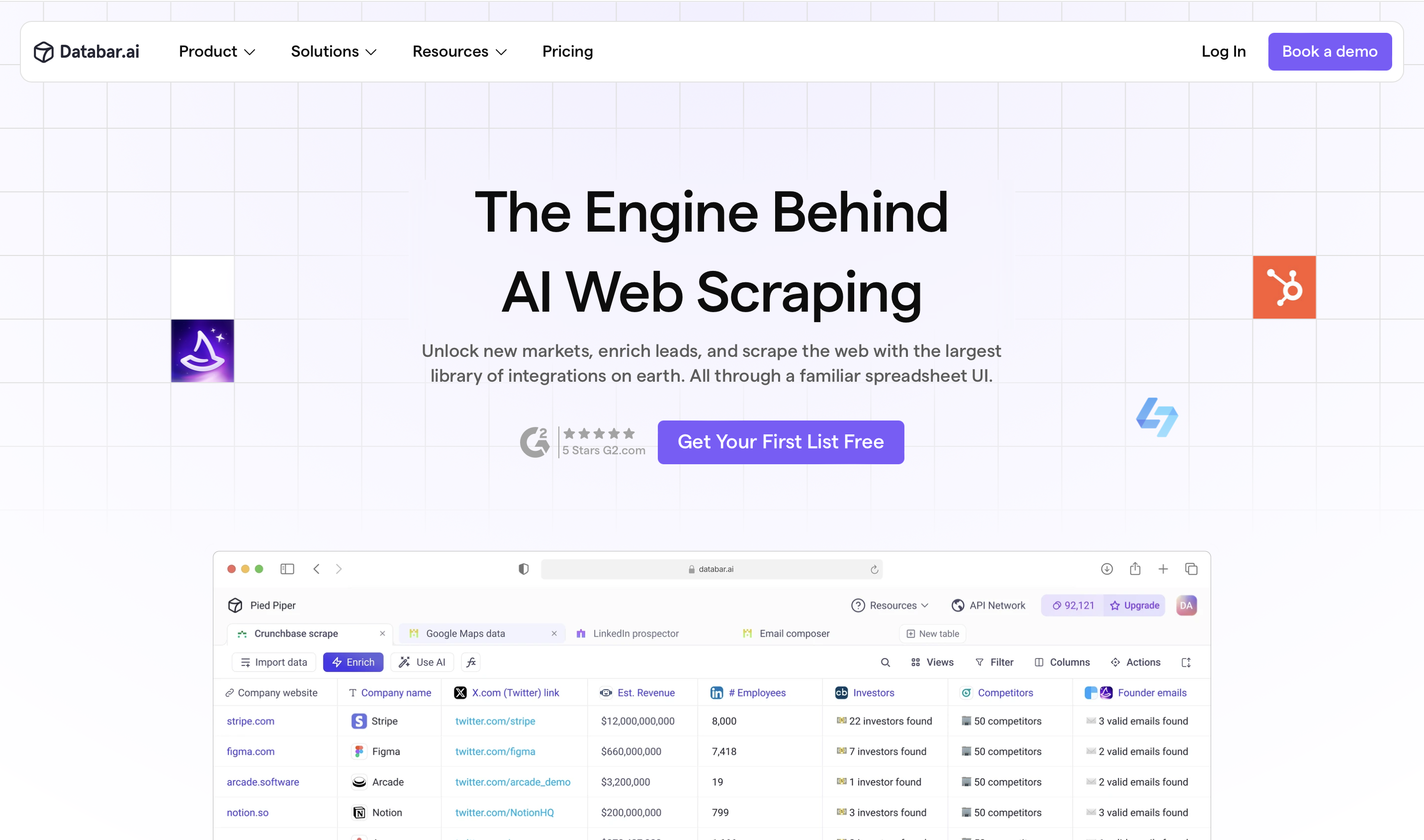
Databar.ai provides a comprehensive lead enrichment API designed specifically for developer teams building custom solutions. Our platform combines access to 90+ data providers through unified endpoints with advanced features like SDK support and white-label infrastructure.
Technical advantages include unified API architecture that provides access to multiple data sources through consistent endpoints, eliminating the need to manage numerous vendor relationships. SDK support through official SDKs for Python makes integration easy and reduces development time.
White-label infrastructure allows you to build your own interface using Databar's enrichment infrastructure, perfect for agencies and SaaS platforms serving multiple clients. Waterfall enrichment automatically tries multiple data sources until complete profiles emerge, maximizing match rates while optimizing costs. Real-time processing delivers sub-2-second response times for standard enrichment requests with intelligent caching for frequently accessed data.
The developer experience includes comprehensive API documentation with interactive testing, webhook support for asynchronous processing, transparent rate limiting with clear upgrade paths, and competitive pricing.
White-label capabilities set Databar.ai apart. Agencies and SaaS companies can offer enrichment services under their own brand. The infrastructure handles scaling, compliance, and data management while you maintain complete control over user experience and pricing.
Databar.ai works best for development teams building custom enrichment solutions, agencies requiring white-label capabilities, and organizations prioritizing cost efficiency with enterprise-grade features.
Clearbit: Enterprise Solution
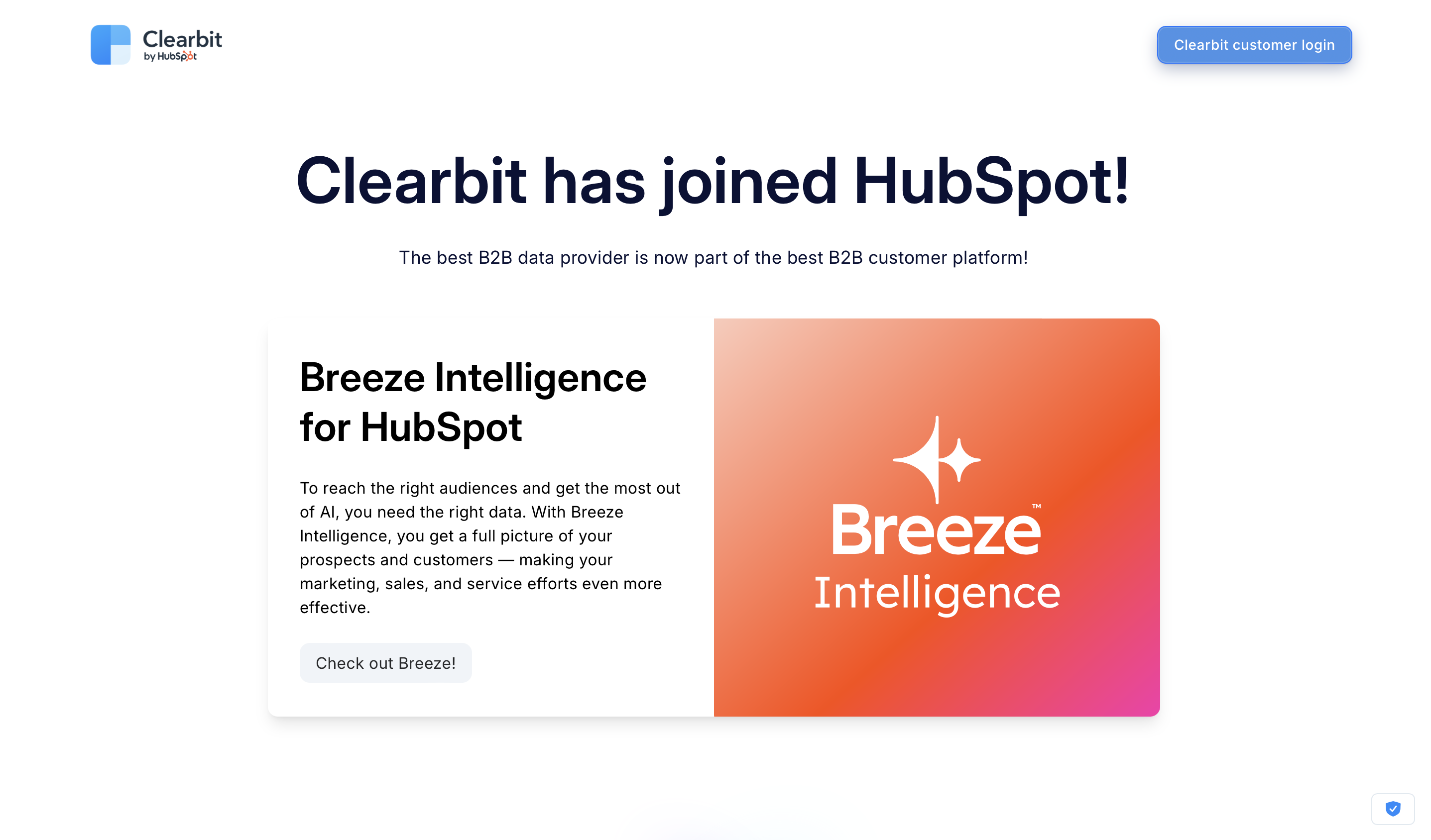
Clearbit's lead enrichment API has established itself as the enterprise standard, particularly after HubSpot's acquisition. The platform emphasizes data quality and compliance features that meet enterprise requirements.
Technical strengths include comprehensive data coverage with 100+ attributes per contact, real-time enrichment with AI-powered change detection, robust webhook system for event-driven architectures, and enterprise-grade security and compliance certifications.
Strong documentation and reliable performance characterize the developer experience, but premium pricing may limit usage in high-volume applications. API rate limits can be restrictive for batch processing scenarios.
Apollo.io: Database-First Approach

Apollo.io provides lead enrichment APIs backed by their proprietary database of 275+ million contacts. This approach offers different trade-offs compared to aggregation-based services.
Technical features include direct database access that reduces enrichment latency, built-in lead scoring through API endpoints, comprehensive search and filtering capabilities, and integrated engagement tracking for enriched contacts.
Apollo's API works best when building on their existing data model. Custom enrichment workflows may require adapting to their data structure and field mappings.
ZoomInfo: Premium Data Quality
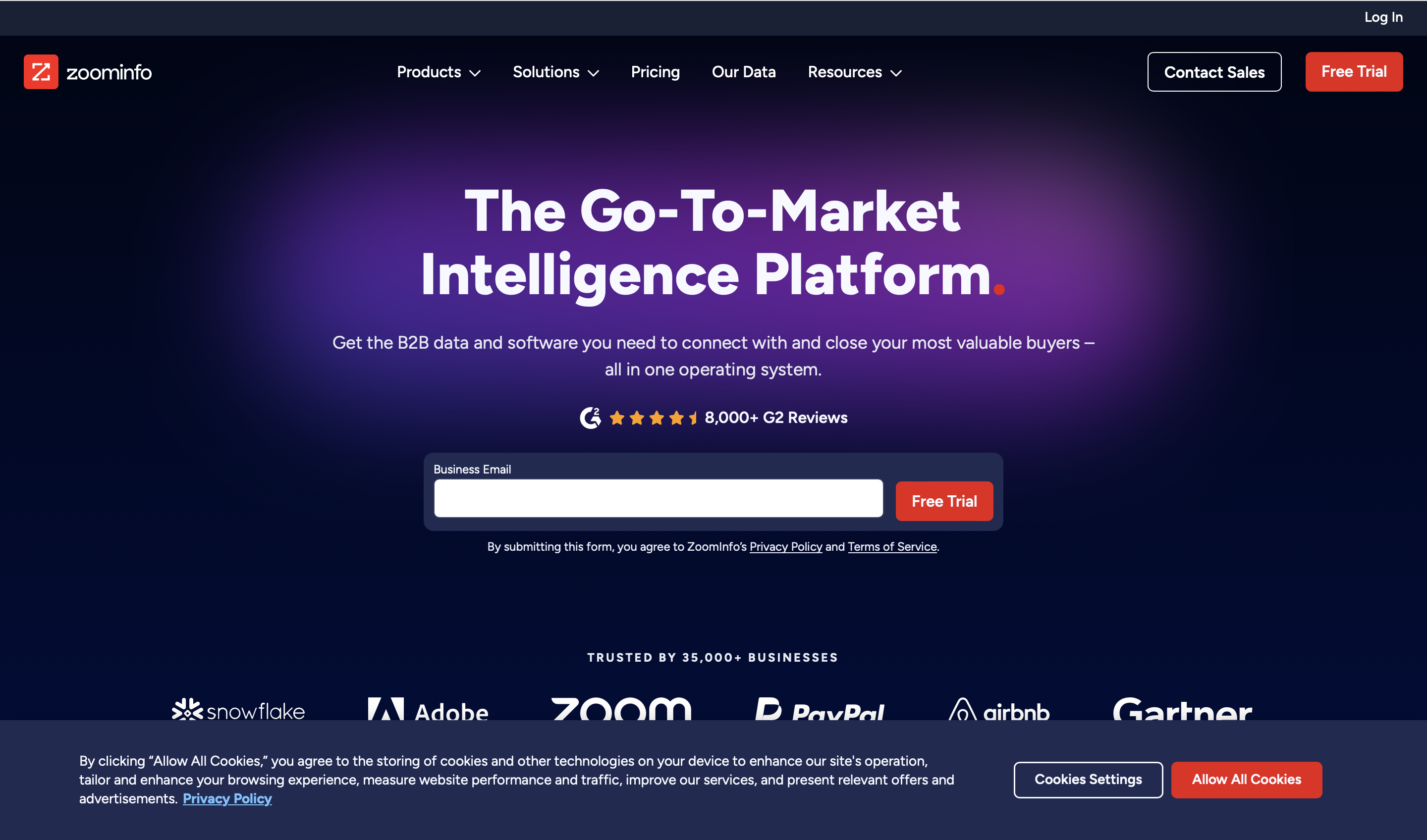
ZoomInfo's lead enrichment API targets enterprise customers requiring guaranteed data quality and extensive compliance features.
Technical capabilities include verified contact data with quality guarantees, advanced search APIs with complex filtering, batch processing support for large datasets, and dedicated infrastructure for high-volume customers.
Premium pricing starting at $15,000+ annually makes ZoomInfo suitable primarily for large-scale enterprise implementations.
Lusha: Developer-Friendly Option
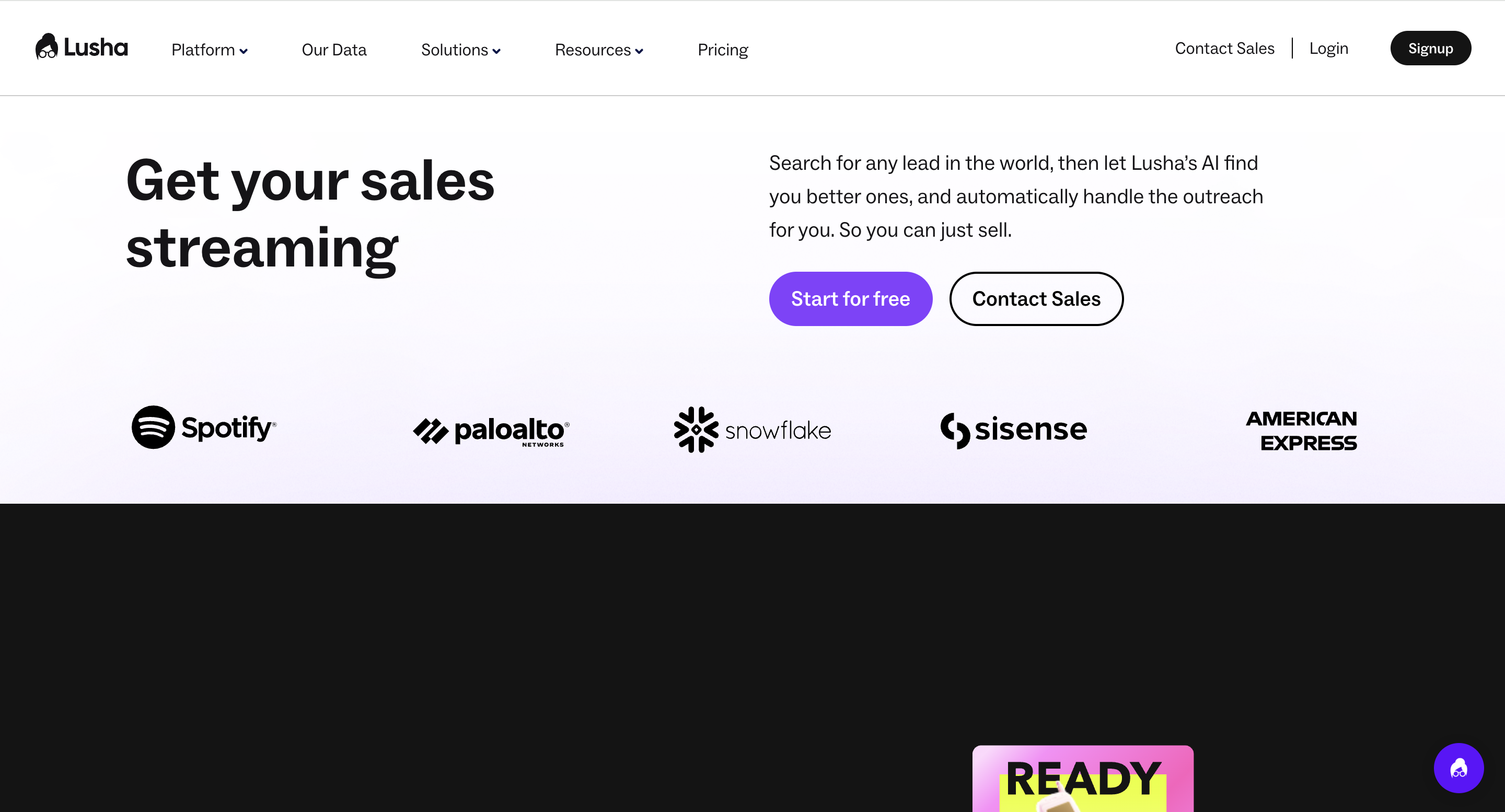
Lusha provides lead enrichment APIs with a focus on ease of integration and competitive pricing for mid-market developers.
Technical benefits include simple REST API with clear documentation, real-time enrichment with CRM integration helpers, flexible pricing based on actual usage, and good performance for European and GDPR-compliant data.
Lusha works well for teams needing straightforward enrichment without complex workflow requirements.
Implementation Check
Successful lead enrichment API implementations require attention to operational concerns beyond basic functionality.
Authentication and security matter more than most developers initially realize. Modern lead enrichment APIs use API key authentication with optional OAuth for more complex scenarios. Store API keys securely using environment variables or dedicated secret management services. IP whitelisting provides additional security for sensitive applications. Some APIs support this feature for enterprise customers, adding an extra layer of access control.
Production systems require comprehensive monitoring of API performance, costs, and data quality trends. Track API response times and success rates, enrichment match rates by data type, cost per enriched contact over time, and data quality scores and verification results.
Alerting strategies should trigger on performance degradation, unusual cost spikes, or data quality issues that could impact downstream systems. Usage analytics help optimize enrichment strategies by identifying which data sources provide the best value for different prospect types.
Scaling Challenges Nobody Talks About
Connection pooling improves performance when making numerous API calls. Most HTTP libraries support connection reuse, reducing overhead for repeated requests. Batch processing capabilities vary between APIs. Some support bulk enrichment endpoints that process multiple contacts in a single request, significantly improving efficiency for large datasets.
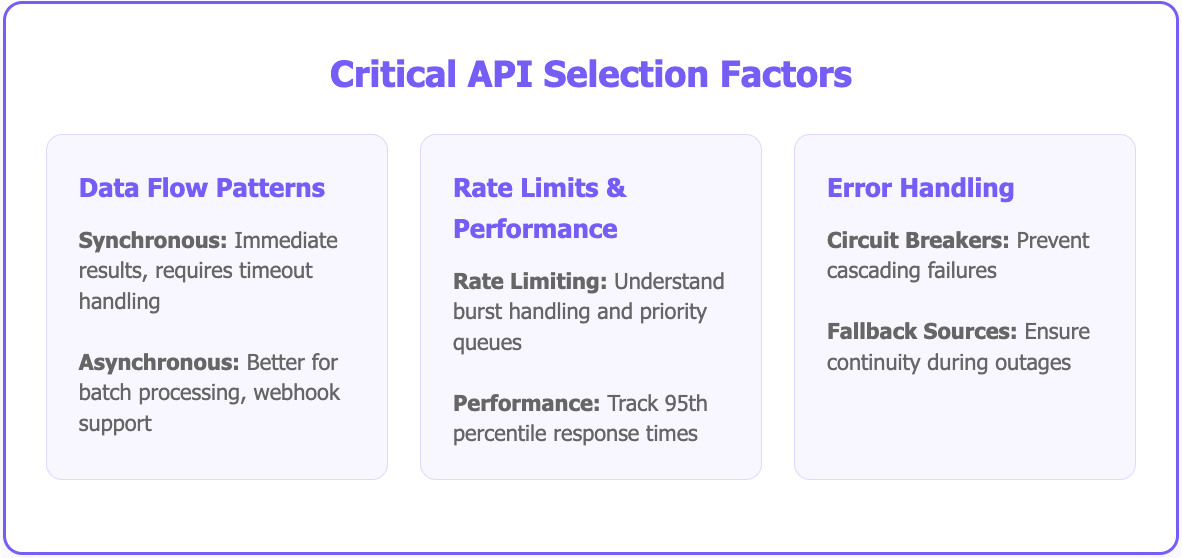
Geographic distribution affects API performance. Providers with global infrastructure typically offer better performance for international applications.
GDPR compliance requires careful handling of personal data in enrichment workflows. Ensure your implementation includes proper consent management and data retention policies. Data minimization principles suggest enriching only the data points necessary for your specific use case. This reduces compliance risk while optimizing costs.
Audit trails help demonstrate compliance with data protection regulations. Log enrichment activities with sufficient detail for regulatory review while protecting sensitive information.
Cost Optimization Strategies That Work
Lead enrichment API costs can quickly escalate without proper optimization strategies.
Implement caching layers that respect data freshness requirements while avoiding unnecessary API calls. Different data types have different update frequencies - job titles change less frequently than email addresses, which change less frequently than phone numbers. Cache invalidation strategies should consider data type, prospect engagement level, and business requirements.
Rather than enriching every contact equally, implement logic that enriches based on prospect behavior, scoring, or engagement level. Trigger-based enrichment processes contacts only when specific conditions are met - form submissions, email opens, website visits from target accounts, or CRM status changes.
Progressive enrichment starts with basic data points and adds additional information based on prospect progression through your funnel. Waterfall strategies maximize match rates while controlling costs. Start with cost-effective providers for basic data and escalate to premium sources only when necessary.
Code Examples That Actually Work
Understanding common implementation patterns helps accelerate development and avoid common pitfalls.
Basic Implementation
import requests
import time
from typing import Optional, Dict
class LeadEnrichmentAPI:
def __init__(self, api_key: str, base_url: str):
self.api_key = api_key
self.base_url = base_url
self.session = requests.Session()
self.session.headers.update({
'Authorization': f'Bearer {api_key}',
'Content-Type': 'application/json'
})
def enrich_contact(self, email: str,
include_company: bool = True) -> Optional[Dict]:
try:
response = self.session.post(
f"{self.base_url}/enrich",
json={
'email': email,
'include_company': include_company
},
timeout=10
)
response.raise_for_status()
return response.json()
except requests.exceptions.RequestException as e:
return None
Error Handling
import backoff
@backoff.on_exception(
backoff.expo,
requests.exceptions.RequestException,
max_tries=3
)
def resilient_enrich(self, contact_data: Dict) -> Optional[Dict]:
return self.enrich_contact(contact_data['email'])
These patterns provide foundation code that can be adapted for specific lead enrichment API implementations.
Choosing the Right Foundation
The optimal lead enrichment API depends on your specific technical requirements, business model, and growth objectives.
For custom application development: Databar.ai provides the flexibility and cost efficiency needed for innovative solutions, with SDK support and white-label capabilities that accelerate development.
For enterprise integration projects: Databar.ai and Clearbit offer the reliability and compliance features required for large-scale implementations, though at premium pricing.
For database-driven applications: Apollo.io provides integrated access to their comprehensive contact database, ideal when building on their data model.
For rapid prototyping: Databar.ai and Lusha offer straightforward APIs with developer-friendly documentation, perfect for proof-of-concept projects.
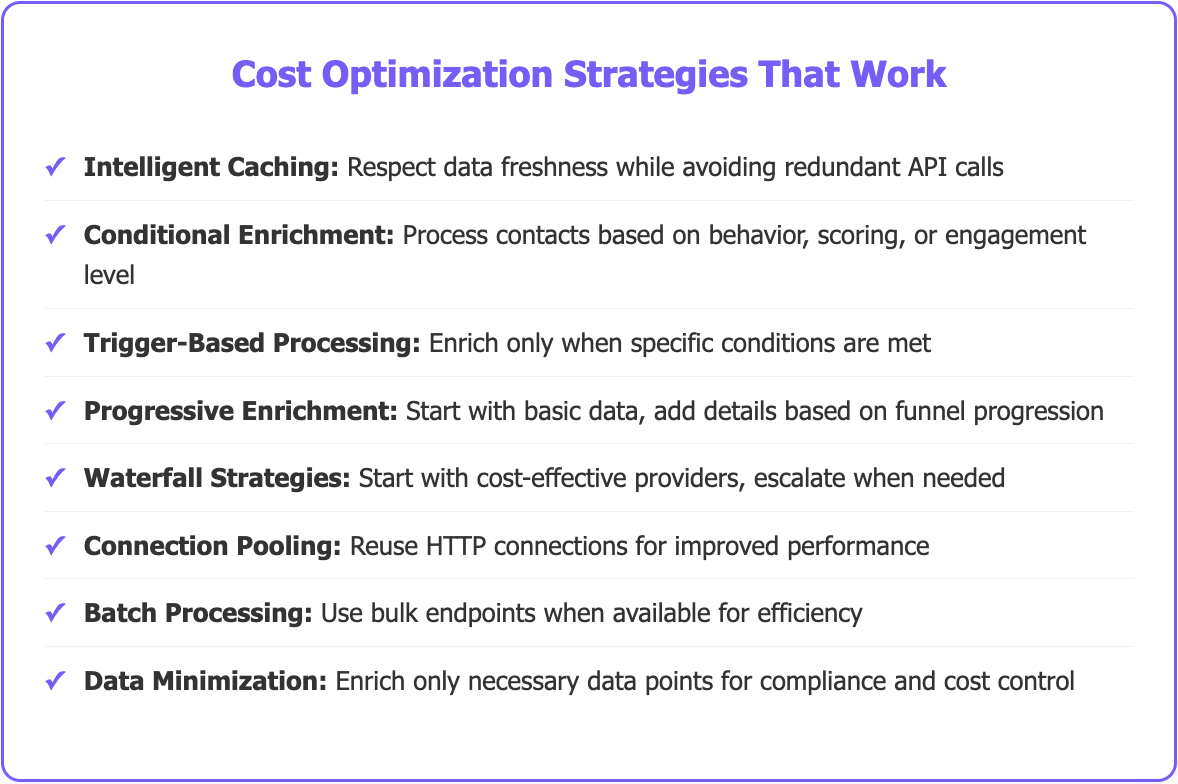
The lead enrichment API ecosystem in 2025 offers sophisticated solutions for every development need. Success depends on choosing APIs that align with your technical architecture, cost requirements, and scalability objectives. Whether building custom applications, integrating with existing systems, or developing white-label solutions, the right API foundation enables innovative approaches to prospect intelligence that drive measurable business results.
Ready to build the next generation of lead enrichment solutions? Explore Databar.ai's developer resources and discover how our APIs can power your applications.
Developer FAQ
How do lead enrichment APIs handle rate limiting?
Most lead enrichment APIs implement rate limiting through token bucket or sliding window algorithms. Check response headers for current limits and implement exponential backoff for retry logic. Databar.ai provides transparent rate limiting with clear upgrade paths as volume grows.
What's the difference between synchronous and asynchronous enrichment?
Synchronous APIs return enriched data immediately within the request-response cycle, while asynchronous APIs accept requests and deliver results through webhooks or polling. Databar.ai supports both patterns depending on your application requirements.
How can I optimize API costs for high-volume applications?
Implement intelligent caching, conditional enrichment based on prospect scoring, and waterfall strategies that start with cost-effective providers
Related articles
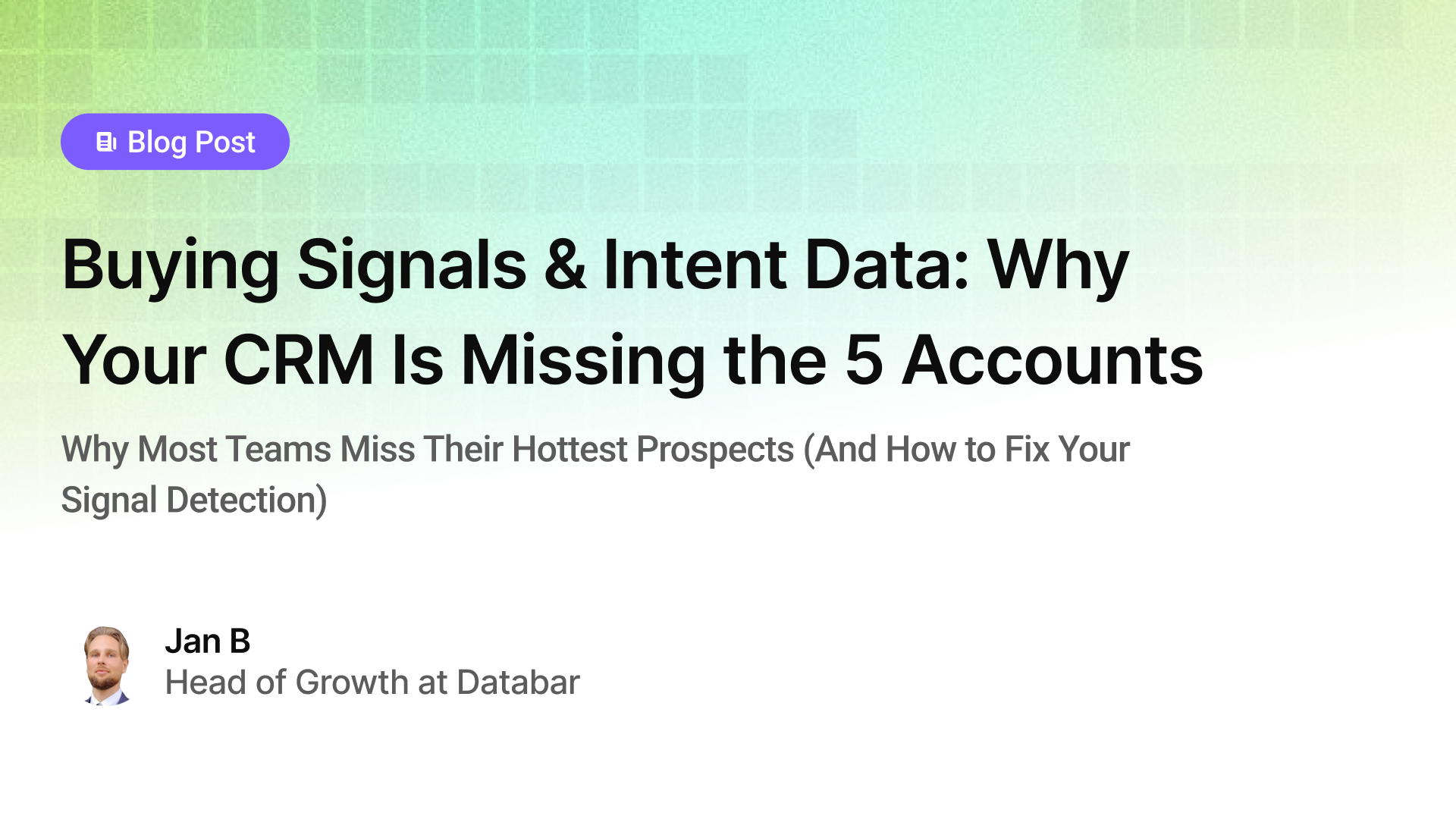
Buying Signals & Intent Data: Why Your CRM Is Missing the 5 Accounts
Why Most Teams Miss Their Hottest Prospects (And How to Fix Your Signal Detection)
by Jan, October 06, 2025

Lead Scoring & Account Segmentation: Why Most CRMs Get This Backward (And How to Fix It)
How to build a system that tells your team who to call, when, and why
by Jan, October 06, 2025
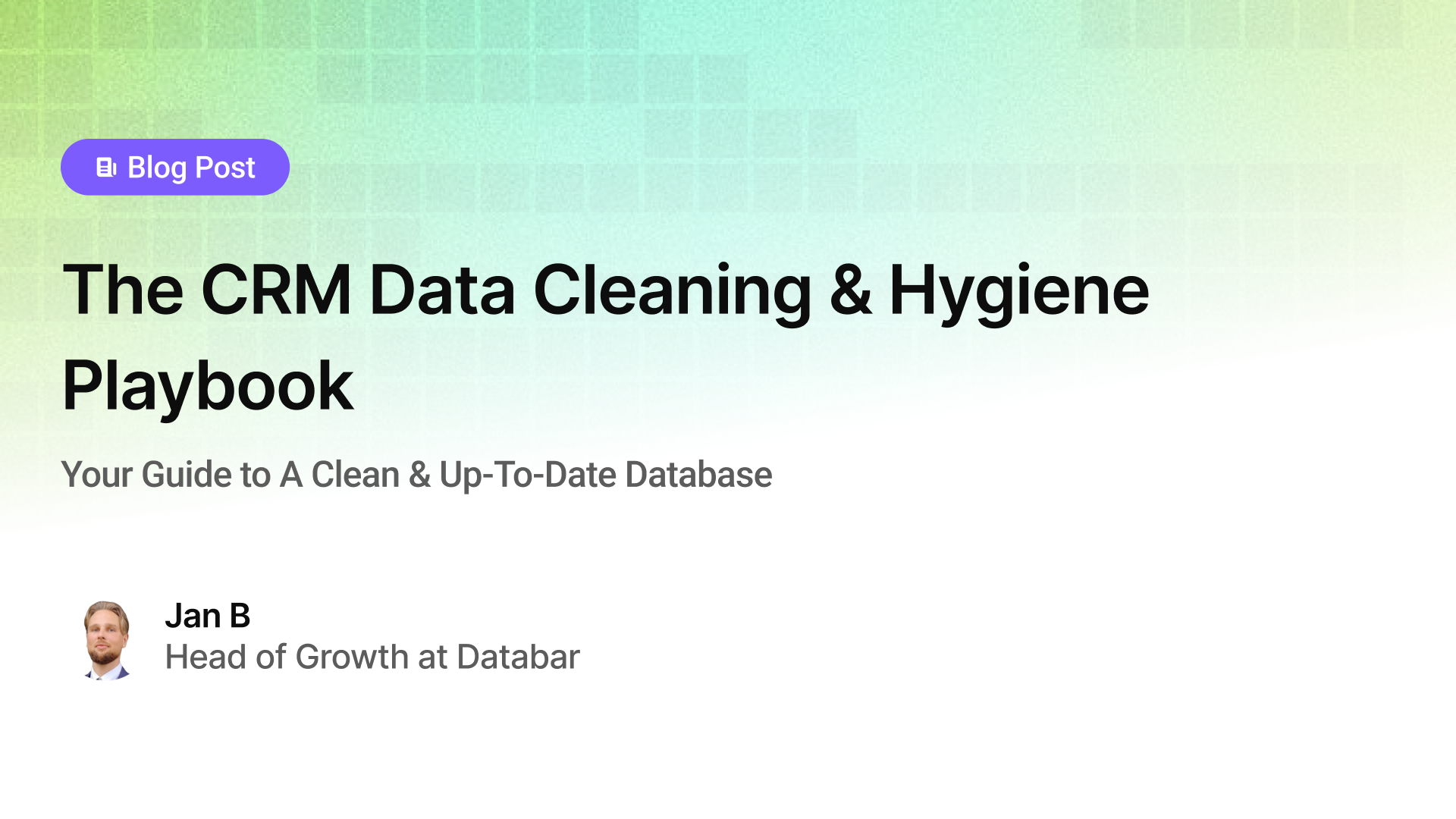
The CRM Data Cleaning & Hygiene Playbook
Your Guide to A Clean & Up-To-Date Database
by Jan, October 04, 2025
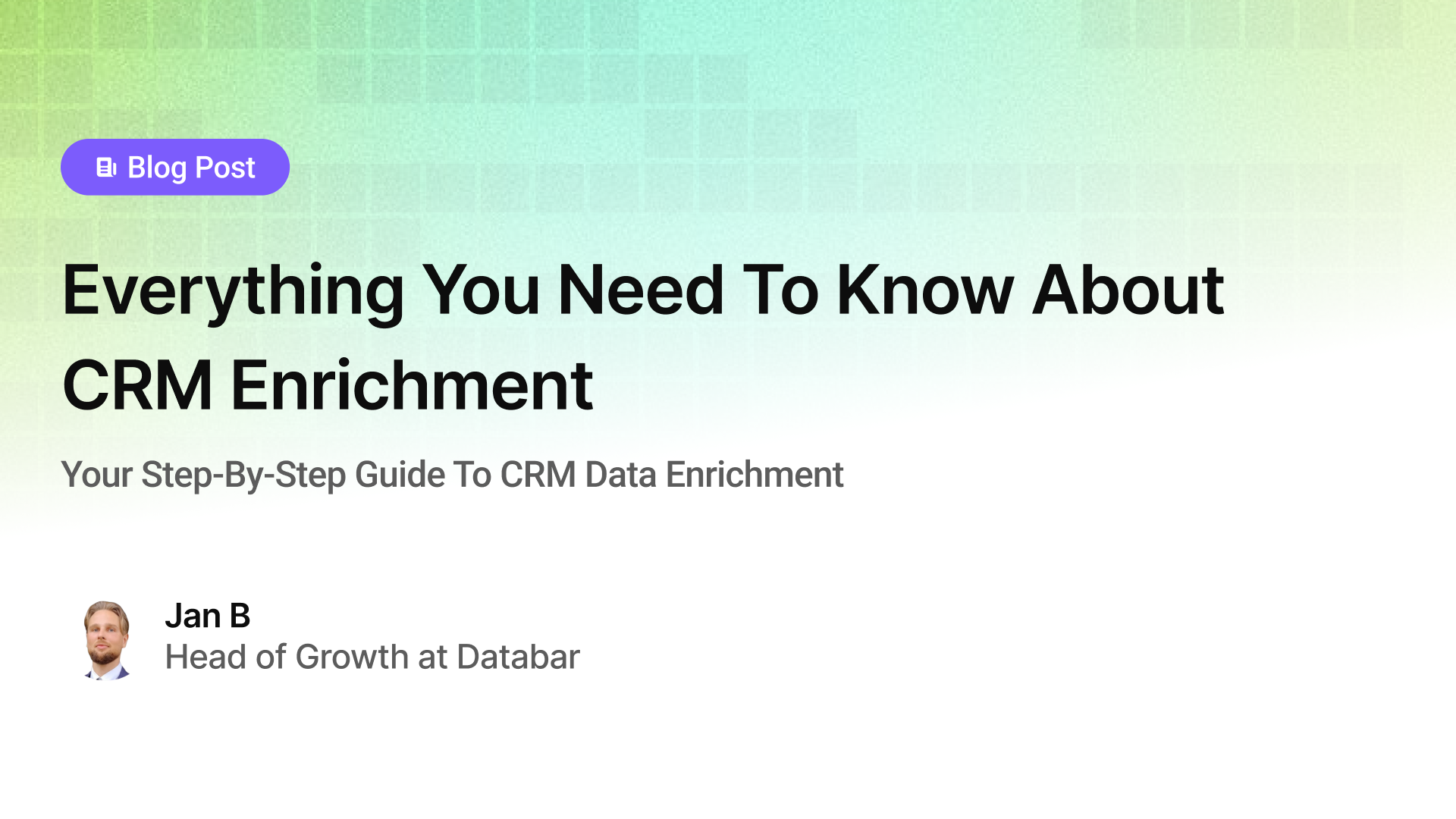
Everything You Need To Know About CRM Enrichment
Your Step-By-Step Guide To CRM Data Enrichment
by Jan, October 03, 2025

